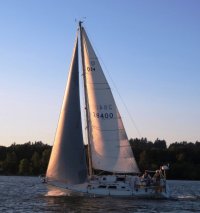My 2 cents...
We had an interesting sail this weekend in the local Icicle Regatta. The first leg was a close reach with 22kts of apparent wind. We were heeled pretty far under 130% genoa and full main. The helm was quite heavy, but we managed to keep our course all the way to the mark. We averaged probably 7.9kts and hit 8.1 kts along the way.
8.1 knots translates to a minimum of 36.5' of waterline and our boat has a listed waterline of 30'. Heeling is our friend. But that much heel creates all that weatherhelm. I felt at times that our main wasn't doing a darn thing, the wash from the genoa was backwinding the front half of the main and at times the whole main. But the boat just plowed on.
We need the waterline to make that kind of speed, can we do anything about the weatherhelm that accompanies that condition? Can we have our cake and eat it too?
Is there some way to measure out the waterline vs heel angle? I've got a inclinometer to install, it just hasn't reached the top of the list yet.
Any thoughts would be appreciated!
Chris
I agree with what others have posted about reefing your main and that you might want to move your headsail leads aft but there are some other things you can try as well. Can you move your headsail leads outboard? There are ways to do this without having to re-run the sheets. When you're that overpowered it often helps to open the slot.
As for vang, if I'm reading your post correctly you tensioned the vang to try to flatten the sail? If so, you might want to try loosening the vang to get more twist in the main and thus allow it spill some wind where it has the most leverage to heel your boat (near the head).
Are the speeds you mention from GPS or from your knot meter? If GPS then consider the impact of things like current (tidal or otherwise). Hull speed is not an absolute, it's just a point at which the energy required to go any faster becomes much higher.
Another thought regarding speed that may help you with your racing. Forgive me if you already know this but I'll mention it just in case it helps. There is a big difference between velocity made good (VMG) and speed over ground (SOG). VMG is the speed you are making towards a certain point. SOG is the speed you are moving (in whatever direction you happen to be moving) relative to the bottom of the ocean (the ground). For example, if you're moving at 8 knots relative to the ground, but you're sailing in a large curved path towards a fixed waypoint your SOG will be higher than your VMG. If you sail towards the same waypoint but follow a direct line to it then your SOG and VMG are the same.
Here's a key thing to remember when sailing upwind, especially when racing- you go fast by focusing on minimizing how much you go sideways rather than only how fast you go through the water. In other words, focus on maximizing VMG not SOG.
An easy way to do this is to put the weather mark into your GPS then monitor VMG and SOG. Generally the closer you get those numbers the better you're doing in terms of speed.
When you're as overpowered as you describe you may be screaming along but you're also experiencing a lot of leeway (going sideways) and your VMG suffers greatly as a result. That's why it can actually be faster going upwind to reduce sail area and have a slower "hull speed" through the water (but better VMG).
As for the proper amount of heel it varies for different boats and to an extent the water conditions but generally "flat is fast" in that with excessive heel (beyond let's say 15-20 degrees) you start loosing too much lift off the keel, gain leeway, and your VMG tanks.
By the way, you're right to notice the excessive weather helm. It's a good clue that while you may feel you're going fast you're actually going slower in terms of upwind progress. Not just because of leeway but also the huge amount of drag the rudder is creating.
A final thought - if you're just trying to have fun and scream around the water then sailing ridiculously overpowered can create some thrills. Plus I think it's good to learn to handle your boat in a wide range of conditions and trim. If nothing else so you can learn to manage the situation while you take steps to get her back on her feet.
Good luck, I hope I'm not saying anything stupid and that this helps!

 ). I have had similar sails in our E30+ where the boat is going much faster than the hull speed formula would think possible, heeled over, crashing through the waves, etc.
). I have had similar sails in our E30+ where the boat is going much faster than the hull speed formula would think possible, heeled over, crashing through the waves, etc.